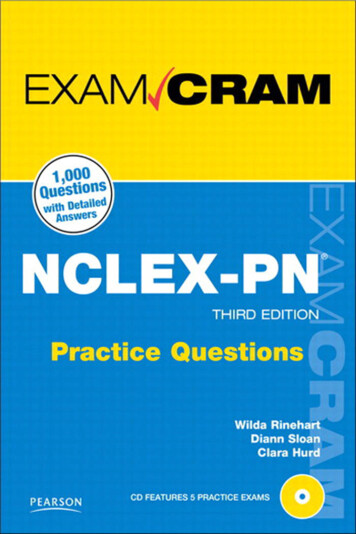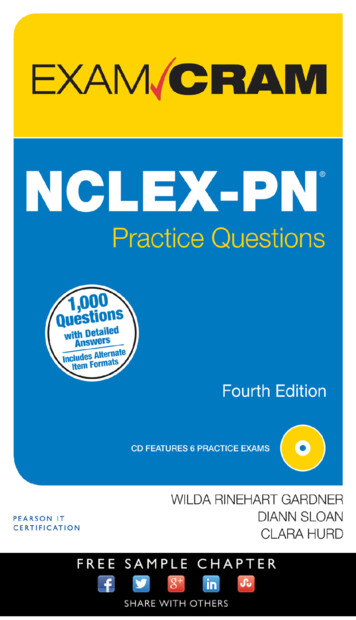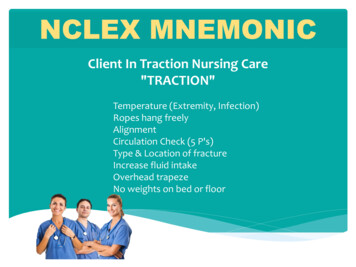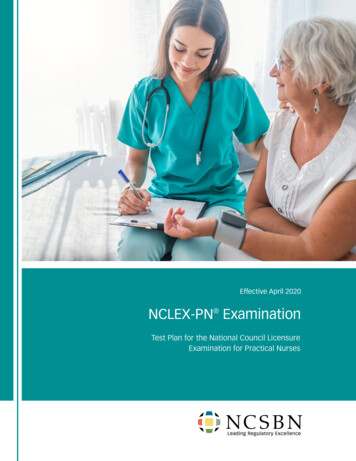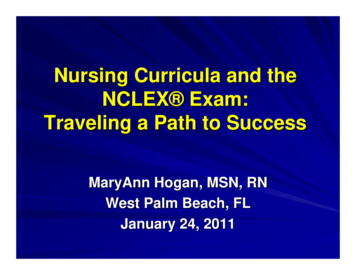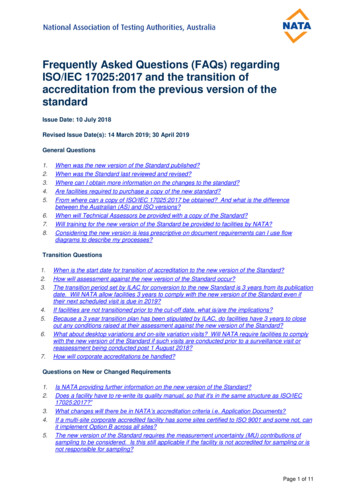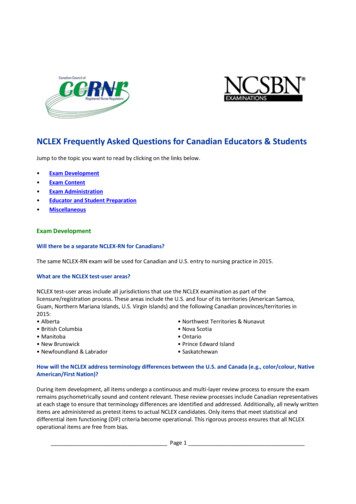
Transcription
NCLEX Frequently Asked Questions for Canadian Educators & StudentsJump to the topic you want to read by clicking on the links below. Exam DevelopmentExam ContentExam AdministrationEducator and Student PreparationMiscellaneousExam DevelopmentWill there be a separate NCLEX-RN for Canadians?The same NCLEX-RN exam will be used for Canadian and U.S. entry to nursing practice in 2015.What are the NCLEX test-user areas?NCLEX test-user areas include all jurisdictions that use the NCLEX examination as part of thelicensure/registration process. These areas include the U.S. and four of its territories (American Samoa,Guam, Northern Mariana Islands, U.S. Virgin Islands) and the following Canadian provinces/territories in2015: Alberta Northwest Territories & Nunavut British Columbia Nova Scotia Manitoba Ontario New Brunswick Prince Edward Island Newfoundland & Labrador SaskatchewanHow will the NCLEX address terminology differences between the U.S. and Canada (e.g., color/colour, NativeAmerican/First Nation)?During item development, all items undergo a continuous and multi-layer review process to ensure the examremains psychometrically sound and content relevant. These review processes include Canadian representativesat each stage to ensure that terminology differences are identified and addressed. Additionally, all newly writtenitems are administered as pretest items to actual NCLEX candidates. Only items that meet statistical anddifferential item functioning (DIF) criteria become operational. This rigorous process ensures that all NCLEXoperational items are free from bias.Page 1
How are you dealing with the need for items related to Inuit/First Nation/Northern population?Identifying cultural factors that impact client population is part of the nursing process, which includesassessment/data collection, analysis, planning, implementation, and evaluation. The nursing process is part ofthe content foundation assessed on the NCLEX exam. During care, the nurse gathers data/collects informationwhich includes the client’s individual cultural factors. Using this information, the nurse plans care based on theindividual client’s needs, considering if these factors negatively impact safety as well as potential complications.The delivery of safe, effective entry-level nursing care requires the ability to incorporate culturally competentcare.Can you explain more about the panel processes including Canadian representation, qualificationrequirements and the recruitment process for entry-level nurses?Over the course of a year, Canadian nurses will represent 20% of the volunteers invited to participate on NCLEXItem Development Panels (Practice Analysis and Knowledge, Skills and Abilities [KSA] expert panels, item writing,item review and Panel of Judges [POJ]). In addition to these item development opportunities, Canadian nurseswill also have the opportunity to review NCLEX items during the Regulatory Body Review and the TranslationReview.All qualified Canadian nurses who are registered with the provinces and territories that will utilize the NCLEX-RNas entry-to-practice examination in 2015 are eligible to participate in the examination development process, andvolunteers will be selected from across Canada to ensure diversity of practice setting, clinical specialty,experience and geographic representation. Canadian nurses began participating on the RN Item Review and RNItem Writing panels in February 2013.To construct meaningful examination items, NCLEX item writers must be familiar with entry-level nursingknowledge, test construction process and item development theories. These necessary qualifications are in-linewith those of nursing educators. Educators with a master’s level or higher degree who are teachingundergraduate nursing students in the clinical areas are invited to participate in the NCLEX-RN item writingprocess. Nurses who hold a PhD and teach solely in the classroom may participate on other item panel typessuch as the Practice Analysis and KSA expert panels.Input from entry-level nurses is sought out in many areas of the item development process such as PracticeAnalysis and KSA expert panels and the POJ. NCSBN will contact the Canadian regulatory bodies when recruitingnew graduates for an item development panel. These governing bodies will recommend names of entry-levelnurses for participation.Additional information about volunteering for the item development program can be found on the ExamDevelopment Opportunities page of the NCSBN website.How do you determine that the practice assessment of entry-level nurses coincides with standards of practiceand expert opinion of the expected practices? How do you determine what questions are on the practiceanalysis surveys?NCSBN conducts practice analyses to determine the level of competency that entry-level nurses must possess inorder to provide safe and effective care. Results obtained from the practice analysis studies are used toconstruct the NCLEX-RN Test Plan. The current NCLEX-RN Test Plan can be downloaded for free on the NCLEXTest Plans page of the NCSBN website. The Test Plan then guides subject matter experts serving as item writersPage 2
and reviewers in the development and review of NCLEX items. All NCLEX items undergo rigorous reviews prior tobeing used in actual examinations. Item content is scrutinized for currency, accuracy and adherence to entrylevel nursing scope of practice.Scope of entry-level nursing practice provides the foundation for the NCLEX item development process. Thepractice analysis process starts with a comprehensive literature review of those resources that studentspreparing for a career in nursing are expected to study and understand. A subject matter expert panel is thenconvened to discuss activities that entry-level nurses perform on the job. This expert panel is made up ofrepresentatives from various NCLEX test-user areas, major nursing specialities and nursing practice settings. Inaddition to 10-12 experienced nurses, the expert panel also includes 2 entry-level nurses. These entry-levelpanelists provide the incumbent perspective. After extensive discussion and review of related documents, theexpert panel constructs a comprehensive list of job activity statements that are relevant to entry-level nursingpractice. This list of entry-level activities will be used in the subsequent practice analysis surveys. The resultsfrom the current practice analysis can be downloaded from the Practice Analyses page of the NCSBN website.The selection and input of subject matter experts provides assurance that the practice analysis assesses thecurrent expected practices of entry-level nursing.Will practice analysis be done with Canadian nurses?Yes, Canadian nurse representatives will be involved in the Subject Matter Expert Panel for RN practice analysesalong with nurses from other NCLEX-RN test-user areas. NCSBN conducts practice analysis studies every threeyears to survey the nursing profession regarding entry-level practice. Results of these practice analyses will formthe basis of NCLEX-RN Test Plan. The next RN practice analysis cycle, which will include Canadian representativeson the Subject Matter Expert Panel and Canadian nurses in the practice analysis survey, is scheduled to begin inNovember 2013.How do you ensure that the practice analysis is representative of all settings (i.e., not just acute care)?When assembling the practice analysis subject matter expert panel, NCSBN ensures that a wide variety ofpractice settings are represented. A representative panel composition ensures that the list of entry-level nursingactivities developed by the panel is inclusive and accurately reflects entry-level nursing practice. Examples ofdifferent practice settings that have been represented on recent NCSBN practice analyses include acute care,critical care, community health, mental health, paediatrics, woman’s health, obstetric, surgery and home health.How will item development panels be selected?Panel dates and the number of panels are determined according to item inventory needs. Item developmentpanels take place throughout the year in Chicago, IL and typically last three to five days. For each panel, NCSBNstaff select qualified volunteer applicants from an item development database depending on the type of paneland specific item pool needs. Volunteers are then approved by their provincial/territorial regulatory body.Additional information about volunteering may be found on the Exam Development Opportunities page of theNCSBN website.How will you ensure diverse practice settings are represented on review panels?To ensure each item development panel consists of a diverse group of nursing experts, NCSBN staff selectsvolunteers representing a variety of practice settings and nursing specialties. Additional panel selection criteriaPage 3
include a variety of geographic representations and years of nursing experience. NCSBN continuously solicitsqualified nursing experts to participate in the NCLEX development process.Will reviewers come from all Canadian provinces?All qualified Canadian nurses who are registered with the provinces and territories that will utilize the NCLEX-RNas entry-to-practice examination in 2015 are eligible to participate in the examination development process, andvolunteers will be selected from across Canada to ensure diversity of practice setting, clinical specialty,experience and geographic representation.How will you ensure review panels are current with standards being taught?To ensure item review panelists are familiar with current nursing practice, only clinicians who work directly withentry-level nurses are eligible to volunteer for the item review process.Can you further explain the rationale behind the criteria for item writers and reviewers?NCSBN recruits nursing instructors in clinical areas as item writers and nurses who are employed in clinicalsettings as item reviewers.To construct meaningful examination items, NCLEX item writers must be familiar with entry-level nursingknowledge, test construction process and item development theories. These necessary qualifications are in-linewith those of nursing educators. Educators with a master’s level or higher degree are invited to participate inthe NCLEX-RN item writing process. In terms of reviewing NCLEX items, nurse clinicians, who work with entrylevel nurses by providing preceptorship, mentorship and supervision, see entry-level practice first-hand. Theseexpert nurses are able to bring their knowledge of the clinical settings to the item review process and ensurethat NCLEX items are reflective of current entry-level nursing practice. Clinicians who spend at least eight hoursper week working with entry-level RNs are invited to serve on NCLEX-RN item review panels. Together, theparticipation of both educators and nurse clinicians ensures that the exam meets the requirements of aregulatory, entry-to-practice requirement focusing on public safety.Why can’t educators who have previous experience in nursing licensure exams item writing participate inNCLEX development?We ask that subject matter experts with nursing licensure examination item development experience or whohave been involved in the development of prep guides or courses in the previous two years to not volunteer forthe NCLEX to minimize potential biases that these previous experiences may bring to the NCLEX developmentprocess.How do review panels decide if an item is removed/sent back for further work?Clinicians who work directly with entry-level nurses are recruited to participate in the test development processas item reviewers. Their charge is to review items based on currency and accuracy of entry-level practice as theysee in various clinical settings. If items are deemed not reflective of current nursing practice, they are sent backfor rework.Page 4
Will travel costs for item writers and reviewers be covered? Where will they need to travel to?NCSBN will cover all expenses for volunteers participating in item development panels including food, lodgingand travel. All item development panels are held in Chicago, Illinois.How will the exam be translated?In order to meet the needs of French-speaking, Canadian NCLEX-RN candidates, NCSBN will offer the NCLEX-RNexamination in French. NCSBN will translate two operational item pools each year into French. Following thisforward translation by a translation professional with expertise in Canadian French, NCSBN will work withCanadian regulatory bodies to identify a Canadian Translation Panel. The panel will consist of three nursesproficient in English and French who will review each translated item for accuracy and contextual equivalency.This method, referred to as a mixed method, process oriented approach, is supported in the literature as apreferred method for ensuring construct equivalence in health care measurement instruments.Following the Canadian Translation Panel’s approval the French NCLEX Operational pool will be administered toFrench Canadian NCLEX-RN Candidates. Once sufficient candidate response data is obtained, the items will besubject to a separate Differential Item Functioning (DIF) analysis, to ascertain whether the items appropriatelymeasure candidates’ nursing ability irrespective of the language in which these test items were administered.Items identified as possessing DIF will be reviewed by the NCLEX DIF panel for presence of bias. In addition tothe construct equivalence confirmed by the Canadian Translation Panel, the use of DIF analysis is supported inthe literature as a preferred method to ensure measurement equivalence.Will reference material be available in French?Yes, the NCLEX-RN Test Plan, NCLEX tutorial and Candidate Bulletin will be available in French prior to 2015.Exam ContentCan you explain the research conducted prior to using the NCLEX-RN in Canada?In 2009, NCSBN sent surveys to 2,396 first-time, Canadian-educated nursing candidates (699 in British Columbiaand 1,697 in Ontario) who successfully passed the Canadian Registered Nurse Examination (CRNE) in 2009. Thesurvey required the candidates to rate 142 nursing activity statements on how important and how frequentlythey are performed considering client safety and/or the threat of complications or distress. The 142 nursingactivity statements were identical to the list of activity statements placed on the 2008 RN Practice Analysissurvey sent to U.S.-educated candidates the results of which informed the 2010 NCLEX-RN Test Plan.The results of the surveys, identified in the Comparison of Entry-level Registered Nurses in the U.S. and BritishColumbia, Canada and Comparison of Entry-level Registered Nurses in the U.S. and Ontario, Canada, indicatedthat respondents considered the activity statements listed in the survey as representative of the work theyperformed in their practice settings. Additionally, the importance and frequency ratings of the 142 activitystatements were comparable to the U.S. respondents with respect to client safety and/or the threat ofcomplications or distress. Given the strong correlation between the importance and frequency ratings, theresults of the two studies firmly suggest that the entry-level RNs in British Columbia, Ontario and the U.S. viewentry-level nursing practice similarly.Page 5
Based on this information, NCSBN continued to explore comparisons in nursing practice in the U.S. and Canada.The 145 RN competencies identified in the College of Nurses of Ontario (CNO) National Competencies in theContext of Entry-Level Registered Nurse Practice were compared in the following three areas: 142 activitystatements identified in NCSBN’s 2008 RN Practice Analysis; the knowledge, skills and abilities (KSAs) needed bynewly licensed RNs to practice safely identified in the 2008 Knowledge of Newly Licensed Registered NursesSurvey; and the NCLEX Integrated Processes described in the 2010 NCLEX-RN Test Plan (NCLEX IntegratedProcesses are defined as processes fundamental to the practice of nursing and therefore are integratedthroughout the NCLEX-RN Test Plan. They include the Nursing Process, Caring, Communication/Collaborationand Teaching/Learning).Using the existing entry-level competency category structures, the study sought to identify equivalent areas inthe competency-based statements that are used as a foundation to assess the ability of the entry-level nurse todeliver safe and competent care in the respective locations. The study revealed a well-defined pattern ofsimilarity in the entry-level nursing competencies between Ontario and the U.S. While there are a few healthcare system nuances in both the U.S. and Canada, one of the most important findings is that the competencycategories, which reflect direct client care by entry-level RNs, represented a 98.54 percent correlation; thelargest overall percentage of direct one-to-one competency agreement between Ontario and the U.S.Considering the results of this research, it is fair to conclude that there is an established relationship of similarityin the entry-level nursing practices between Canada and the U.S. This relationship strongly suggests that theNCLEX-RN Examination would provide a fair, valid, and psychometrically sound measurement of the minimalnursing competencies required for safe and effective practice for those seeking registration/ licensure as an RNin Canada.How do you ensure that Canadian candidates will not be expected to answer questions on skills that are notconsidered entry-level in parts of Canada (i.e., ventilators, arterial lines, etc.)?In 2010, NCSBN conducted several research studies comparing nursing practice and nursing competencies in theU.S. and Canada. The results of these studies revealed a 98% congruency in nursing practice and competenciesbetween the two countries. Canadian regulatory bodies will conduct a review of operational NCLEX items toensure all items administered starting in 2015 are congruent with regulatory nurse practice acts and entry-levelscope of practice in the 10 provinces/territories.How do the Entry-to-Practice (ETP) competencies in Canada relate to the items that will be on the exam?The NCLEX-RN is based on the data collected from the practice analysis studies (see the Exam Development FAQsection) conducted every three years. NCSBN conducted background research on the nursing practice in the U.S.and Canada, which included a comparison of the Canadian ETP competencies with the entry-level nursingactivity statements as used in the RN practice analysis. Study results revealed a high degree of correspondencebetween the Canadian ETP competencies and the RN entry-level nursing activity statements. Additionally,NCSBN conducted practice analysis verification studies in collaboration with College of Nurses of Ontario andwith College of Registered Nurses of British Columbia. Study results indicated that entry-level practicecharacteristics among the U.S., Ontario and British Columbia are highly similar. Full reports for the Ontario andBritish Columbia studies are available on the Exams Publications page of the NCSBN website.Prior to writing the NCLEX-RN, nursing students complete an educational program that teaches them theknowledge, skills and abilities that will prepare them to enter the nursing profession. Nursing candidates’academic preparation provides a starting point for them to practice in a variety of settings. In complement, thePage 6
NCLEX-RN is developed to assess whether nursing candidates possess the minimal entry-level competence toprovide safe and effective care.Does the exam assess components related to community health?NCLEX-RN items are developed based on healthcare settings in which entry-level RNs practice. These settingsinclude acute/critical care, long-term/rehabilitation care, outpatient care and community-based/home care.Each item development subject matter expert panel is carefully assembled to ensure that a diverse group ofnurses are represented. These panels include item writing, item review, practice analysis, and every other panelalong the test development process. NCSBN pays attention to demographic characteristics such as geographicalareas, gender, practice settings and nursing specialties, to name a few. Community-based nursing practice alongwith other nurse practice settings, are selected to ensure comprehensive representation in the overall testdevelopment process.Community health concepts, including social determinants of health and the care of populations, areincorporated throughout the test plan categories and the items that are subsequently developed based on thesecategories. The entry-to-practice exam focuses on the validation of required entry-to-practice competencies andis not intended as a comprehensive validation of the acquisition of program content.Can you describe the risk management category of questions?NCLEX-RN items that assess risk management are categorized in the Safe and Effective Care Environment sectionunder the Management of Care test plan area. Management of Care items measure areas where nurses provideand direct nursing care that enhances the care delivery setting to protect the client and other healthcarepersonnel. This area addresses professional responsibility competencies where nurses manage client care,engage in client advocacy and provide care continuity.How are ethical components of nursing practice and critical thinking measured on the NCLEX exam?Ethical components of nursing practice are addressed in the practice analysis and as a result are representedamong the entry-level job task statements that form the test plan categories. Questions measuring nursingethics are asked on the NCLEX-RN exam just as questions that measure other nursing competencies. The examas a whole assesses the student’s application of critical thinking across the test plan categories and thecompetencies associated with the provision of nursing care.How will issues regarding American drug names and measurement values be addressed for Canadian writers?The NCLEX-RN items currently include both metric and imperial measurement options. Over the next two years,our transition process and the review by Canadian experts will ensure the appropriateness of terms used in theexam for both Canadian and American candidates, and that all writers of the NCLEX-RN in 2015 will be assessedbased only on nursing competence, not his or her place of origin.How will content related to Canadian health care history, the Canadian medical care system, and Canadianlegislation be addressed on the exam?In order to be psychometrically sound and valid as a regulatory entry to practice examination, the NCLEX-RNexam must measure nursing competence, not the candidate’s knowledge of a particular health care system,history or legislation. However, candidates must be able to identify the potential impact of the context in whichPage 7
care is provided on his or her approach to providing nursing care. The NCLEX will include questions that willassess the candidate’s ability to apply critical thinking in these scenarios.Differential item functioning (DIF) analysis is conducted on all exam results to ensure that the exam items aremeasuring only nursing competence. If items perform differently based on an individual’s place of origin, thenwhat is likely being measured is not nursing and the item would be removed.Canadian nursing students will continue to acquire the required knowledge about legislation, policies, standards,and context affecting their practice as a nurse in Canada in their educational programs, and will build on thisknowledge as they progress in their career as a nurse.Exam AdministrationWhen is the exam starting in 2015?The NCLEX exam will begin administration for Canadian entry-to-practice in January 2015.What are the fees for taking and retaking the NCLEX? Why is the registration fee not the same as in the U.S.?The current NCLEX registration fee, as established by contract, for candidates seeking licensure/registration byCanadian Regulatory Bodies is 360 CDN. This fee is the same for each registration regardless of the number oftimes the candidate has taken the NCLEX-RN. The fee is based on the set of services required to meet the needsof Canadian candidates (including the provision of a French version of the exam and the establishment of testcenters in Canada). This application process and fee is distinct from the process and fees for application forregistration/licensure with provincial/territorial regulatory bodies. Candidates will continue to require approvalfrom their regulatory body before they are eligible to write the exam.Will Canadian NCLEX candidates have the same passing score (cutscore) as U.S. NCLEX candidates?Yes, the NCLEX-RN passing standard will be the same for U.S. and Canadian entry to nursing practice. Currentlythe NCLEX-RN passing standard is 0.0 logit. Find more information on how the NCLEX passing standard is set onthe Passing Standards page of NCSBN.org.How do you determine which centers a candidate can use to write the NCLEX?One of the benefits of the exam model CCRNR chose is in the flexibility it provides candidates seekinglicensure/registration from Canadian regulatory bodies. Canadian candidates may sit for the NCLEX-RN at anyPearson Professional Center (the permanent test sites) in Canada, any Temporary Test Center, and any PearsonProfessional Center located in the U.S. Appointments at permanent Pearson Professional Centers are availableyear round. Once candidates are made exam eligible by the regulatory body, they can select any test center inwhich to write the NCLEX-RN. Candidates will schedule their NCLEX-RN using the Pearson VUE Website or byphone with Pearson VUE's call center.Page 8
Will there be French personnel to answer the needs of the unilingual French candidates at the temporary andpermanent test centers in remote areas?Pearson VUE will be recruiting bilingual individuals to staff its permanent and temporary test centers. While notevery invigilator will be bilingual, NCSBN and Pearson VUE will work with regulatory bodies to serve the needs ofunilingual French candidates.Is all biometric registration and student data going to be housed in the U.S. or Canada? How do you addressconcerns about the privacy of Canadian students?Canadian and provincial law allows for the transmission of data to a service provider in the U.S., subject tomeeting the standards of Canadian and provincial/territorial privacy laws. Under the contract between theregulatory bodies and NCSBN, NCSBN will comply with U.S., Canadian and provincial/territorial laws. NCSBN andPearson VUE have established a system of security, consent, and notice standards related to the collection andtransmission of such data.How long can students work as a graduate nurse before they take the NCLEX?The NCLEX is only part of the nursing regulatory licensure/registration process. As such, any otherlicensure/registration requirements or policies are determined by the regulatory body in the jurisdiction inwhich the candidate is seeking registration/licensure. Candidates will need to contact their regulatory body forfurther information.If a Canadian student takes the NCLEX for licensure/registration in Canada, will they be able to work in theU.S.?The NCLEX is only part of the nursing regulatory licensure/registration process. As such, any otherlicensure/registration requirements or policies are determined by the regulatory body or board of nursing in thejurisdiction in which the candidate is looking to practice. Candidates will need to contact the regulatory body orboard of nursing for further information on the requirements and how these can be met.How long does it take for candidates to receive the results and how are they notified?The regulatory bodies will be developing administrative processes to support the delivery of the NCLEX as of2015. Detailed information will be available in the second half of 2014. NCLEX candidates will receive theirresults directly from the regulatory bodies, and CCRNR’s collective goal is to provide the results to candidates assoon as possible after the examination.What will the cost to students be?The cost for Canadian students to take the NCLEX-RN has currently been established at 360 CAD. There may beadditional administration fees payable to the regulatory body in the jurisdiction to which the student is applyingfor licensure or registration. These administrative details will be finalized over the next two years andcommunicated to students as soon as they have been determined.Page 9
Do students get more anxious if they continue to write and they know that a longer exam means the less wellthey are doing?As a candidate takes the examination, items are selected based on the candidate's response to previous items.The examination ends when the computer can determine that a candidate's performance is either above orbelow the passing standard based on pre-established scoring criteria, regardless of the number of itemsanswered or the amount of testing time elapsed. A longer exam does not indicate that a candidate is performingpoorly. It only indicates that the candidate’s ability is close to the passing standard and more questions areneeded to ascertain the candidate’s ability is either above or below the passing standard. Additional informationon the pass/fail rules can be found on the Computerized Adaptive Testing page of the NCSBN website.Can candidates skip questions? Do they have the ability to go back to a question?Every time a candidate answers an item on the NCLEX, the computer re-estimates the candidate’s ability basedon his or her responses to all of the previous items. The computer then selects the next item targeted to thecandidate’s ability. In order ensure items are targeted to a candidate’s ability, the computer will not allow acandidate to skip items or return to previous items. Candidates are encouraged to co
The current NCLEX-RN Test Plan can be downloaded for free on the NCLEX Test Plans page of the NCSBN website. The Test Plan then guides subject matter experts serving as item writers _ Page 3 _ and reviewers in the development and review of NCLEX items. All N

